
All satellite dishes incorporate a
parabolic curve into the design of their bowl-shaped reflectors. The
parabolic curve has the property of reflecting all incident rays arriving
along the reflector's axis of symmetry to a common focus located to the
front and center. The parabolic antenna's ability to amplify signals is
primarily governed by the accuracy of this parabolic curve. Poor antenna
performance can result from inaccuracies in the dies used to manufacture the
reflector surfaces. More often, however, low antenna efficiencies are caused
by the installer's failure to grasp the importance of using good antenna
assembly techniques.
Antenna Materials &
Construction
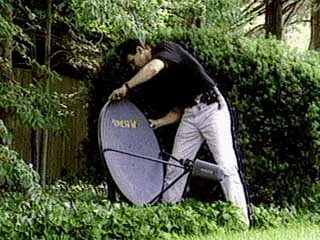 The reflector must be constructed out of metal in order to
reflect the incoming microwave signals. Some antenna reflectors appear to be
manufactured out of plastic or Fiberglas; however, these dishes contain an
embedded metal mesh material that reflects the incoming satellite
signals.
The reflector must be constructed out of metal in order to
reflect the incoming microwave signals. Some antenna reflectors appear to be
manufactured out of plastic or Fiberglas; however, these dishes contain an
embedded metal mesh material that reflects the incoming satellite
signals.
Solid one-piece antennas are most often the best performers
because there are no assembly errors and they will maintain their exact
shape over the lifetime of the system. Solid petalized antennas constructed
out of four or more segments are generally the next best performers.
Potential assembly errors are limited to variations along the seams between
petals. The installer can easily visually inspect these seams during
assembly to ensure that there are no variations in the surface curve from
one petal to the next. One-piece and petalized antennas are also available
in a perforated form. The diameter of the perforation holes is a function of
signal wavelength: too small to pass or resonate with the wavelength of the
incoming microwave signals but large enough to pass light in order to
minimize the antenna's environmental impact.
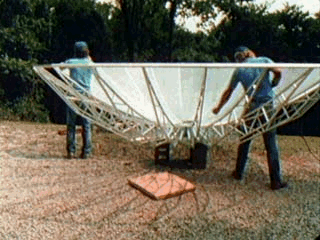 Mesh antennas are the most susceptible to construction
errors. The two-part construction process consists of the building of a
support frame and a series of flexible mesh panels. The installer attaches
the mesh to the frame using a series of metal clips or sheet metal screws.
Mesh antennas also are highly susceptible to environmental effects. Heavy
wind storms, for example, can loosen the clips holding the mesh to the frame
and distort the curve from its original shape or even blow out one or more
of the mesh panels.
Mesh antennas are the most susceptible to construction
errors. The two-part construction process consists of the building of a
support frame and a series of flexible mesh panels. The installer attaches
the mesh to the frame using a series of metal clips or sheet metal screws.
Mesh antennas also are highly susceptible to environmental effects. Heavy
wind storms, for example, can loosen the clips holding the mesh to the frame
and distort the curve from its original shape or even blow out one or more
of the mesh panels.
The installer should examine the antenna at
intervals during the installation process. Close attention should be paid to
how the various petals fit together. The reflector surface should appear to
be continuous, with minimal variation from petal to petal and few noticeable
bumps or waves along the surface of mesh antennas.
Antenna symmetry is
also very important. Improper construction of a petalized antenna can warp
the reflector curvature. The installer should sight along a side view of the
reflector from the near to far edge of the antenna rim. If the near and far
rims of the dish do not line up in parallel with each other then the
installer will need to loosen the bolts holding the petals together and re
tighten them in such as way that the reflector conforms to the
manufacturer's intended shape. Another way to detect warp is to run strings
across the antenna's rim. All strings should lightly touch over the center
of the dish. Any gaps between strings indicate a flaw in the reflector
surface.
Prime Focus Antennas
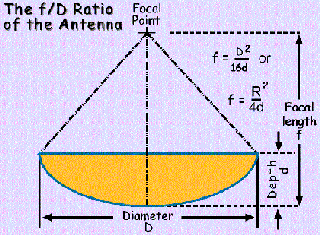 The basic design principle of the parabolic curve can be
incorporated into antenna designs in a variety of ways. Dishes with a focal
point directly at the front and center of the reflector are called prime
focus antennas.
The basic design principle of the parabolic curve can be
incorporated into antenna designs in a variety of ways. Dishes with a focal
point directly at the front and center of the reflector are called prime
focus antennas.
Prime focus antennas are easy to construct and point
toward the desired satellite. There are two main design disadvantages,
however: the feedhorn and feed support structure block part of the reflector
surface and the feedhorn must look back at the dish at such an angle that it
can also intercept noise from the "hot" earth located directly behind the
reflector. The feedhorn's illumination of the antenna must be attenuated or
tapered to minimize noise contribution from the perimeter of the dish. This
design necessity acts to reduce the antenna's efficiency.
Prime focus
antennas use two different types of feedhorn support bracket. A three or
four-legged support provides a rigid support structure for the feedhorn and
LNB over the center of the dish and at the distance specified by the
manufacturer. The main disadvantage of this structural approach is that it
may be difficult to make minor variations in the focal length, that is the
distance from reflector center to the lip of the feed opening. The
buttonhook structural design uses a single support member to position the
LNB and feedhorn. This tubular leg can usually be slid in and out of a clamp
or bracket at the center of the dish, allowing the installer to fine-tune
the focal length. However, the buttonhook support may not always position
the feed at the precise center of the dish, especially when the feedhorn is
weighted down by multiple LNBs.
Motorized dishes may experience feedhorn
movement when the antenna is moved from one satellite to the next; heavy
winds can also temporarily move the feedhorn away from the antenna's focus.
Guy wire kits are available which the installer can use to provide
additional structural rigidity to the buttonhook support if required for a
given installation.
Offset-fed Antennas
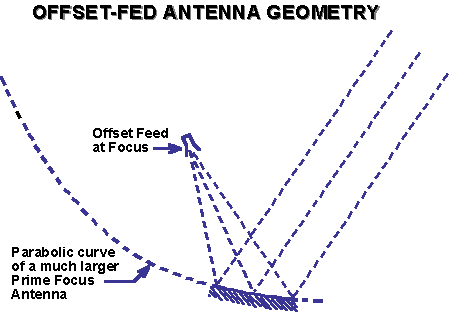 The dish design of choice for most digital DTH systems
is called an offset-fed antenna. Here the manufacturer uses a smaller
subsection of the same parabolic curve used to produce prime focus antennas,
but with a major axis in the north/south direction, and a smaller minor axis
in the east/west direction.
The dish design of choice for most digital DTH systems
is called an offset-fed antenna. Here the manufacturer uses a smaller
subsection of the same parabolic curve used to produce prime focus antennas,
but with a major axis in the north/south direction, and a smaller minor axis
in the east/west direction.
With the offset-fed design, the feedhorn is
no longer positioned at the front and center of the reflector but rather
offset to the bottom of the dish. However, the feed would be centrally
located if we extended the parabolic curve of the offset fed dish to the
full length of a prime focus parabola.
The offset fed antenna design
offers several distinct advantages over its prime focus counterparts. There
is no feedhorn blockage, an important consideration when the antenna
aperture is less than one meter in diameter. Moreover, the offset angle at
which the feedhorn tilts up toward the reflector is such that if the feed
looks over the antenna's rim it will see the cold sky rather than the hot
earth. Due to these advantages, the offset-fed antenna can achieve higher
efficiency levels than prime focus antennas can generally attain.
The
low inclination angles required by offset antennas also may be beneficial in
certain climate zones. In tropical or semi-tropical environments, rain will
not collect inside the reflector. In cold weather climates, snow will slide
off of the antenna surface rather than accumulating inside the reflector.
Cassegrain Antennas
The cassegrain antenna is
most often used for dishes that exceed five meters in diameter. Its use is
primarily restricted to uplink earth stations and cable TV head ends. The
cassegrain design incorporates a small sub reflector located at the front
and center of the dish. The sub reflector deflects the microwaves back
toward the center of the reflector, where the feedhorn is actually mounted.
Like the prime focus dish, the cassegrain antenna's view of the
satellite is partially obscured, in this case by the sub reflector. However,
when the diameter of the dish exceeds 5m, the percentage of blockage is
actually quite small.
This type of antenna obtains higher efficiencies
because the feedhorn looks up at the cold sky and the required illumination
taper is reduced. The precise manufacturing tolerances required to implement
this dual reflector approach, however, increases the manufacturing cost and
adds complexity to the installation process.
Spherical
Antennas
The spherical antenna design creates multiple focal
points located to the front and center of the reflector, one for each
available satellite. The curvature of the reflector is such that if extended
it outward far enough along both axes it would become a sphere.
Spherical antennas are primarily used for commercial SMATV and cable
installations where the customer wishes to simultaneously receive multiple
satellites with a single dish. These satellites must be within +/- 20
degrees of the reflector's axis of symmetry.
Planar
Arrays
Some digital DTH systems in Japan and elsewhere have
elected to use an alternate antenna design called the planar array. These
flat antennas do not rely on the reflective principles used by all parabolic
dishes. Therefore no feedhorn is required.
Instead a grid of tiny
elements is embedded into the antenna's surface. These elements have a size
and shape which causes them to resonate with the incoming microwave signals.
A spider's web of feed lines is used to interconnect all the resonant
elements in such a way that their signal contributions are all combined in
phase at a single terminal located at the center of the array which connects
directly to the LNB.
Planar arrays are relatively unobtrusive: there is
no feedhorn and the LNB is located to the rear of the antenna out of sight.
Since these antennas are most always dedicated to the reception of a single
satellite or constellation of collocated satellites, they can be mounted in
a fixed position on an outer wall or rooftop.
One main disadvantage of
the planar array is its limited frequency bandwidth which is about 500 MHz.
Parabolic antennas, however, have a broad bandwidth; a single dish, for
example, can be used to receive S, C, and Ku-band satellite signals. Another
disadvantage of the planar array is the high construction cost: more than
four times the cost of manufacturing a feedhorn and parabolic reflector with
equivalent signal amplification characteristics.
Antenna Gain
and G/T
The gain of a satellite antenna is the measurement of
its ability to amplify the incoming microwave signals. Gain, which is
expressed in decibels, or dB, is primarily a function of antenna capture
area or aperture: the larger the antenna aperture, the higher the antenna
gain. Gain also is directly related to antenna beam width: the narrow
corridor or "boresight" along which the antenna looks up at the sky.
The
antenna's efficiency rating is the percentage of signal captured by the
parabolic reflector that actually is received by the feedhorn. As we have
previously seen, the feed-horn's illumination of the outer portion of the
dish is attenuated or tapered, which leads us to conclude that antenna gain
is not as important a factor as it might first appear to be.
The
ultimate figure of merit for all receiving antennas is the G/T (pronounced
"G over T"); that is, the gain of the antenna (in dB) minus the noise
temperature of the receiving system (in dB). A typical C-band DTH system
will have a G/T of around 20 dB/K, while most Ku-band digital DTH systems
have a G/T of 12.7 dB/K. The more powerful the satellite signal, the lower
the G/T value that will be needed at the receiving system down on the
ground.
The noise value (T) primarily comes from two sources. The antenna
noise is a function of the amount of noise that the feedhorn sees as it
looks over the antenna rim towards the hot earth (which has a noise
temperature of 290 K). Antenna noise generally ranges between 30 and 50 K.
The noise contribution of the LNB's internal circuitry is the other
major source of concern. C-band LNB performance now ranges as low as 20 K.
If we add an antenna/feed noise of 40 K to LNB noise of 35 K = 75 K. Ten
times the Logarithm of 75 K equals a (T) of 18.8 dB. A typical 1.8m diameter
C-band antenna will produce a gain of 38 dB. Therefore the G/T of the system
described above would be (G) 38 dB minus (T) 18.8 equals 19.2
dB/K.
Deep Versus Shallow Dishes
 The parameters of the parabolic curve that the antenna designer
selects can be adjusted to create a variety of focal length to antenna
diameter (f/D) values. Antennas which have an f/D greater than .38 are said
to be shallow, whereas dishes will an f/D less than .33 are said to be
deep.
The parameters of the parabolic curve that the antenna designer
selects can be adjusted to create a variety of focal length to antenna
diameter (f/D) values. Antennas which have an f/D greater than .38 are said
to be shallow, whereas dishes will an f/D less than .33 are said to be
deep.
Although the long focal length afforded by the shallow dish design
increases the feedhorn's ability to illuminate the entire reflector surface,
we have already seen that there are distinct disadvantages to doing this.
Moreover, antenna noise increases as antenna elevation increases. Shallow
dishes are more susceptible to intercepting earth noise when pointing at low
elevation angles. Finally, the shallow dish is more susceptible to picking
up terrestrial interference from microwave relay stations.
The deep dish
trades off gain in order to lower antenna noise performance. The deep-dish
design is an attractive alternative for locations that potentially may
experience terrestrial interference problems or at installations which
require low antenna elevation angles. The deep-dish design positions the
feedhorn relatively close to the rim of the reflector. Therefore the deep
dish has a greater ability to shield the feedhorn from potential TI sources.
However, the feedhorn is so close to the reflector that it cannot illuminate
the entire surface.
Antenna Side Lobe
Rejection
The explosive worldwide growth in satellite
telecommunications is leading to closer spacing between satellites in
geostationary orbit. What's more, the very latest satellites are
transmitting higher-powered signals than ever before. Both of these
developments act to increase the potential for interference from nearby or
adjacent satellites.
The perfect parabolic antenna would only receive
signals from the satellite at which it was pointed while rejecting all
signals coming from other directions. In the real world, however, each
antenna design will produce a main beam along the axis of symmetry as well
as other beams of lower intensity that look out at adjacent angles. These
beams of lower intensity are called "sidelobes".
The goal of all
satellite TV antenna manufacturers is to reduce the gain of these sidelobes
to levels that are at a minimum of 15 dB below the gain of the main lobe.
This level of sidelobe attenuation is usually sufficient for preventing
adjacent satellites from causing interference to reception of the desired
satellite. The location off axis of each sidelobe is a function of antenna
diameter and signal frequency. The installer can therefore select an antenna
that is large enough to put the adjacent satellites in the first "null" of
the antenna receiving pattern or use an antenna which has a sidelobe that is
at least -15 dB down from the main beam.
Antenna
Mounts
The steel mount and the bearing that supports the antenna
reflector must be able to maintain a precise position once boresighted onto
the desired satellite. A misalignment of the mount of as little as two
inches can make the difference between perfect TV reception and no reception
at all. The installer should check the rigidity of the mount by grasping the
rim and gently shaking it to see if there is any "play" as wind or
rainstorms may push the dish off of boresight, causing erratic
reception.
All mounts incorporate adjustments that permit the installer
to point the dish at the desired satellite. Digital DTH antennas commonly
have what is known as a fixed mount that is adjusted once at the time of
installation and then left alone thereafter. The fixed mount has separate
settings for the required azimuth (compass bearing corrected to true north)
and elevation (the angle at which the reflector tilts up at the sky).
Motorized DTH antennas must rotate in an arc that mimics the curvature
of the geostationary arc where all the satellites are located. A modified
form of the polar mount used by astronomers on their telescopes is used to
achieve this effect. The axis of the modified polar mount must be aligned
with the earth's axis of rotation at an angle that corresponds to the
latitude of the receiving site. Precise tracking of the geostationary arc
also requires a declination adjustment that tilts the antenna downward
slightly in the direction of the geostationary arc. This modification to the
polar mount is required because of the relative closeness of the satellites
in comparison to the stars that astronomers view with polar mounted
telescopes.

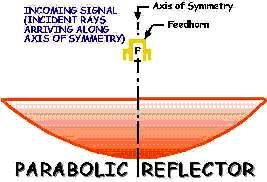
 The reflector must be constructed out of metal in order to
reflect the incoming microwave signals. Some antenna reflectors appear to be
manufactured out of plastic or Fiberglas; however, these dishes contain an
embedded metal mesh material that reflects the incoming satellite
signals.
The reflector must be constructed out of metal in order to
reflect the incoming microwave signals. Some antenna reflectors appear to be
manufactured out of plastic or Fiberglas; however, these dishes contain an
embedded metal mesh material that reflects the incoming satellite
signals. Mesh antennas are the most susceptible to construction
errors. The two-part construction process consists of the building of a
support frame and a series of flexible mesh panels. The installer attaches
the mesh to the frame using a series of metal clips or sheet metal screws.
Mesh antennas also are highly susceptible to environmental effects. Heavy
wind storms, for example, can loosen the clips holding the mesh to the frame
and distort the curve from its original shape or even blow out one or more
of the mesh panels.
Mesh antennas are the most susceptible to construction
errors. The two-part construction process consists of the building of a
support frame and a series of flexible mesh panels. The installer attaches
the mesh to the frame using a series of metal clips or sheet metal screws.
Mesh antennas also are highly susceptible to environmental effects. Heavy
wind storms, for example, can loosen the clips holding the mesh to the frame
and distort the curve from its original shape or even blow out one or more
of the mesh panels.  The basic design principle of the parabolic curve can be
incorporated into antenna designs in a variety of ways. Dishes with a focal
point directly at the front and center of the reflector are called prime
focus antennas.
The basic design principle of the parabolic curve can be
incorporated into antenna designs in a variety of ways. Dishes with a focal
point directly at the front and center of the reflector are called prime
focus antennas.  The dish design of choice for most digital DTH systems
is called an offset-fed antenna. Here the manufacturer uses a smaller
subsection of the same parabolic curve used to produce prime focus antennas,
but with a major axis in the north/south direction, and a smaller minor axis
in the east/west direction.
The dish design of choice for most digital DTH systems
is called an offset-fed antenna. Here the manufacturer uses a smaller
subsection of the same parabolic curve used to produce prime focus antennas,
but with a major axis in the north/south direction, and a smaller minor axis
in the east/west direction.  The parameters of the parabolic curve that the antenna designer
selects can be adjusted to create a variety of focal length to antenna
diameter (f/D) values. Antennas which have an f/D greater than .38 are said
to be shallow, whereas dishes will an f/D less than .33 are said to be
deep.
The parameters of the parabolic curve that the antenna designer
selects can be adjusted to create a variety of focal length to antenna
diameter (f/D) values. Antennas which have an f/D greater than .38 are said
to be shallow, whereas dishes will an f/D less than .33 are said to be
deep.







